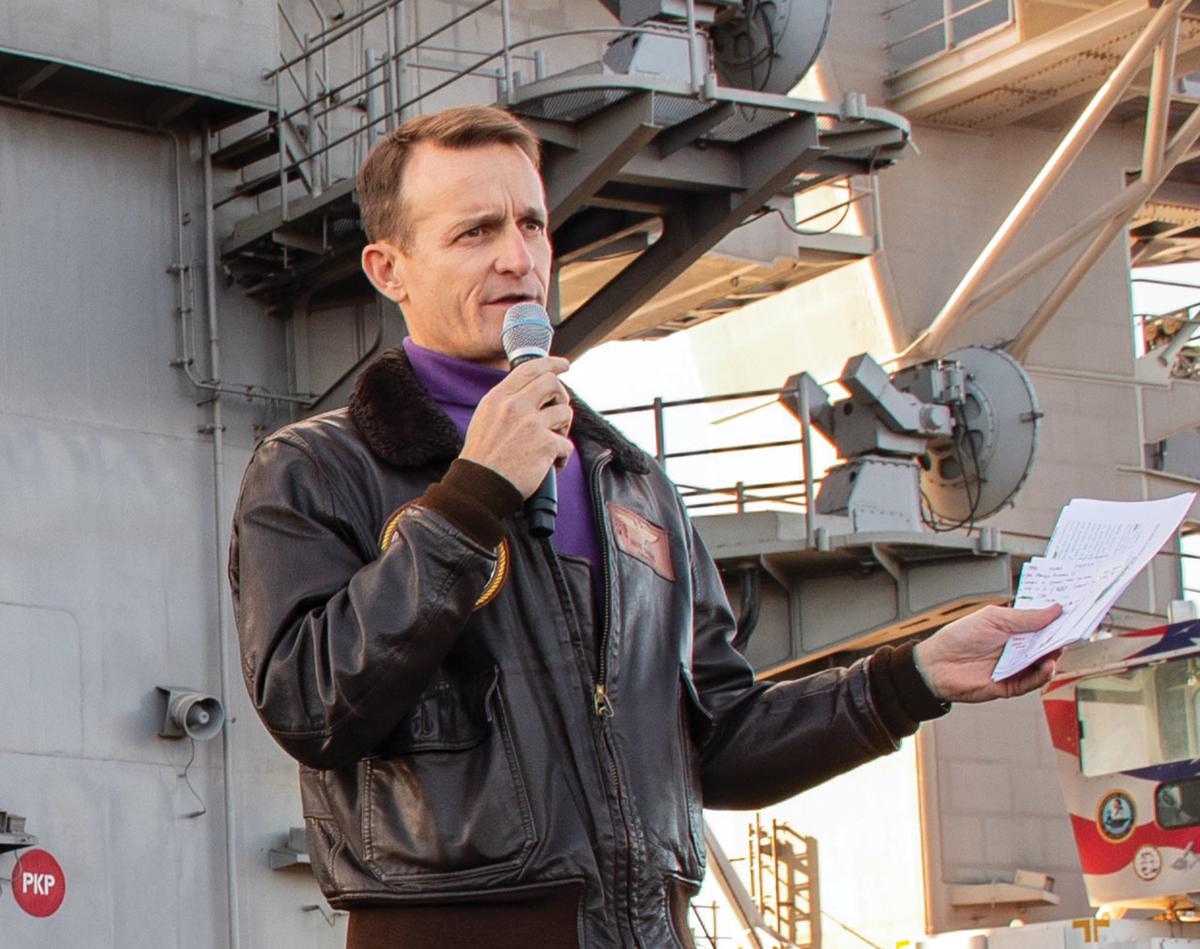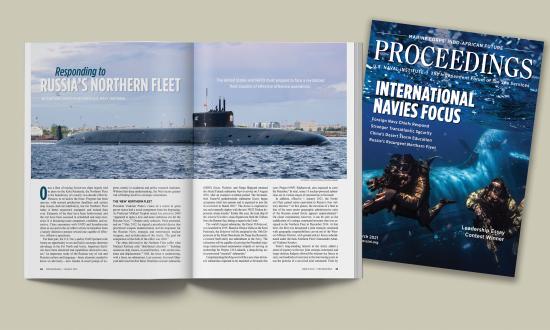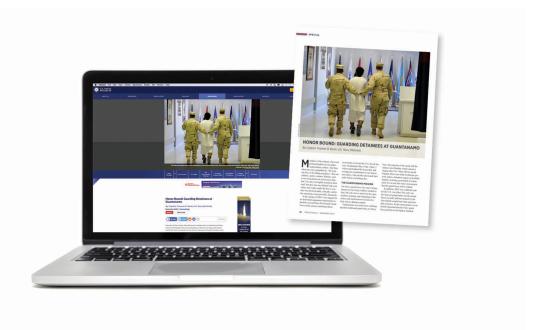Presume the Best, Get the Best
(See J. Zeberlein, pp. 76–78, March 2021)
Early on, the author states that “attempting to relitigate the [Crozier] case is fruitless” but leads the reader to the conclusion that Captain Bret Crozier might have been “keelhauled” and that the Navy must presume good faith, speak truth to power, and other such commonly used leadership “stuff.”
He goes on to challenge junior officers to “glean some wisdom” about the issues and to understand how junior officers may be “disillusioned by what they saw as overreaction to bad publicity.”
Well, to me, Captain Crozier’s concern was warranted, and his desire to let his seniors know was commendable. The problem, however, is that as a senior captain, former squadron commander, and former commander of the Seventh Fleet flagship, he should have known exactly whom to go to and how to do it.
That he did not coordinate his letter/email with his immediate superior—a rear admiral with him on his ship—is inexcusable. Had that superior not satisfied Crozier’s concerns, Crozier’s next step would have been to communicate directly with the Seventh Fleet commander. That’s the only lesson that all future commanding officers must learn.
It would be instructive to learn exactly why this experienced captain failed to follow the chain of command. The author’s excuses could lead one to decide that this captain’s actions were acceptable. They were not. I hope this is the lesson being taught to our midshipmen and junior officers. That this article took first prize in the Leadership Essay Contest leads me to believe otherwise.
—Colonel William M. Rakow, USMC (Ret.)
Accounting for Lethality
(See L. Alford, pp. 16–17, February 2021)
I take exception to Dr. Alford’s assertion that passing a financial statement audit will make more funding available for equipment by reducing fraud and waste. Although Dr. Alford offers the $792 million recovered in 2013–17 from convictions stemming from federal contractor fraud as evidence of the funding to be saved, it is unclear how much of this recovery can be attributed to audit activities.
The first DoD-wide financial statement audit was not conducted until fiscal year 2018, and that audit found zero instances of fraud, as did the second and third DoD audits. Although the money saved by conducting a financial statement audit is unclear, the money spent to conduct the audit is clear—$192 million in fees to auditors, $221 million in government costs to support the audit, $406 million to remediate audit issues, and $153 million on financial system fixes. The grand total was $972 million just to fund the FY2018 audit.
It may seem like I do not believe that passing the audit is a worthwhile goal. In fact, the opposite is true. I have spent years of my career in service of this goal. However, I think it disingenuous to characterize the audit as something it is not. DoD may realize some efficiency gains in pursuit of a clean audit opinion, but it will almost certainly cost much more than any savings that result.
The true purpose of an audit is not to detect or prevent fraud, but, rather, to ensure that financial statements are free from material misstatements. But a statement of budgetary activity free of material misstatements will not make the force more lethal. The Chief of Naval Operations relies on other reports to serve those purposes. A clean audit opinion will allow Congress and the taxpayer to have greater faith in how the Pentagon spends its money and greater confidence in the accuracy of DoD’s reports. The real question is whether these intangible goals are worth the multibillion-dollar price tag.
—Jimmy Beavers, CPA, accounting officer for Commander, Fleet Readiness Centers, Patuxent River, MD
Shelve the Mariner Skills Logbook
(See W. Heath, p. 17, March 2021)
Surface warfare officer (SWO) proficiency has not been achieved, despite many attempts to fix the problem. The Mariner Skills Logbook should be retained based on the fact that “if training is not written down, it didn’t happen.”
Consider some of the many measures that can be taken to help prevent collisions at sea and thus protect life, limb, and property:
Pass an annual Coast Guard rules of the road test. All SWOs through O-6 should be required to do this. This requirement will dramatically increase safety at sea.
Annual bridge simulator training. All SWOs through O-5 should be required to participate in a minimum of two full days of bridge simulator training. This training should simulate recent warship collisions. All officers should be rotated through all the positions on the bridge simulator.
Documented bridge time. In preventing collisions, there is no substitute for bridge management time and competency. All SWOs at sea, regardless of nonbridge assignments, should be required to spend a minimum of a total of ten hours of bridge observation time, especially in high-traffic and congested areas.
USNS bridge observation time. At least once every five years, all SWOs should be assigned to a USNS vessel for several days to observe underway bridge management. This will allow the SWOs to observe merchant ship–style bridge management as conducted by the civilian mariner deck officers.
Eyes and binoculars over radar. It must be stressed that when aids to navigation, another vessel, or land is in sight, eyes and binoculars are critical to ensure the safety of vessel and crew. The tendency to rely completely on radar and collision-avoidance devices must be checked.
Nothing gets within one mile. There is a lot to be said for this standard when it comes to other vessels, aids to navigation, and land.
Best shiphandlers in the world. The submarine community has New London, Connecticut, and naval aviation has Pensacola, Florida. Both warfare communities are recognized throughout the world as best-in-class. This is based on corporate culture, flawless training, and a home center of excellence. The U.S. SWO community must constantly work on all of these to be the best shiphandlers in the world. It is to be hoped that the old saying that the surface warfare community eats its young is not true.
There is another saying—people skills account for 80 percent of one’s success in life, regardless of profession. Leadership is a fundamental people skill.
—CAPT Al Melvin, USNR (Ret.), author, Student Handbook for Success
A Cut Is Not Always a Cure
(See S. Wallace, p. 15, February 2021, and
D. Scott, p. 90, March 2021)
Although we are happy to see Lieutenant Commander Wallace discuss medical staffing in the military, we disagree with both his facts and his conclusions.
First, it is false that “mass mobilization of reservists in any reasonable time frame would be near impossible.” Desert Storm saw 44 percent of the Navy Reserve’s medical forces activated. One of us, an unremarkable Naval Reserve physician, was treating patients within 24 hours.
Second, credentialing does not preclude rapid mobilization. One-day credentialing of Air National Guard physicians at their deployed facility has long been routine. Navy Reserve physicians have their credentialing documents on file at their designated mobilization sites, enabling routine credentialing in advance. Credentialing is merely a collection of rules, easily changed when the will exists.
Finally, we agree that the Defense Health Agency policy is misguided—because it could cut more. The military needs many full-time primary care physicians, but only a few full-time specialty physicians. Civilian specialists can provide care within the United States. Reservist specialists can provide care deployed, and they will do it better because, as Lieutenant Commander Wallace correctly notes, the healthier, less challenging, less numerous patients in military hospitals allow the skills of full-time military physicians to erode. And, of course, reservists are far less expensive, surging only when needed.
Having been continually at war since August 1990, the active-duty Air Force, Air Force Reserve, and Air National Guard function as a unified medical force: Every clinical position in the world has been seamlessly filled, either routinely or urgently, by a reserve forces member. Yet, the active-duty Navy remains at a loss as to how to effectively integrate its reserve medical assets. Sailors and their dependents are receiving less than they deserve.
—Col. John G. Sotos, MC, USAF (Ret.), and CAPT Kevin W. Olden, MC, USNR (Ret.)
High-Speed Ferries for Surface and Amphibious Warfare
(See R. Brodie, pp. 32–36, February 2021)
I applaud Commander Brodie on his advocacy for high-speed vessels for surface and amphibious warfare. Innovative use of existing technology and platforms such as he proposes will enable us to meet the challenge of a peer threat in a time of fiscal constraint.
Looking at his proposal from the perspective of the light amphibious warship (LAW) concept, the current expeditionary fast transport (EPF, formerly the joint high-speed vessel) trimaran has potential merit.
Its shallow draft, speed, and large internal cargo volume make it an excellent starting point for the design of the future LAW. There would have to be modifications, though, to make it an effective enabler for the Marine Corps’ expeditionary advanced base operations (EABO) warfighting concept.
The flight deck would need to be strengthened to handle CH-53 and MV-22 aircraft. Air and surface point-defense weapon systems and electronic support measures would need to be installed as well. The most significant design modification would be to incorporate a bow ramp for direct ship-to-shore loading/unloading. On the beach, such a ramp is vastly superior to stern loading/unloading or beaching in terms of speed of completion and safe shiphandling.
The Navy’s explanation for the LAW design criteria of a stern ramp is that a bow ramp design would limit the ship’s top speed. Yet the stated requirement for speed is only some 14 knots. If high speed is really a requirement, then the EPF or another existing fast trimaran design would be the obvious answer. By design, the bow sits above the water; therefore, an integral ramp built into the bow would not affect top speed.
In any case, high speed should be a requirement for the LAW to best support EABO. Rapidly repositioning Marine littoral regiment units demands a supporting ship with a speed greater than 14 knots. The existing EPF design—with some modifications—seems the obvious solution.
—CAPT Pete Pagano, USN (Ret.)
Welcome Back to the Jungle
(See M. Hanson, pp. 12–13, April 2021)
Captain Hanson’s article was quite interesting. Jungle fighting was a prominent feature in several combat theaters in World War II, notably Burma. It provided some very hard-earned lessons for British and U.S. troops. British Field Marshal Sir William Slim’s great book, Defeat into Victory, recounts a number of the tactical lessons learned in the 1942 campaign that he included in a training memorandum at the time. Most are applicable today. Here are several of his points:
1. The individual soldier must learn, by living, moving, and exercising in it, that the jungle is neither impenetrable, nor unfriendly. When he has once learned to move and live in it, he can use it for concealment, covered movement, and surprise.
2. Patrolling is the master key to jungle fighting. All units, not only infantry battalions, must learn to patrol in the jungle, boldly, widely, cunningly, and offensively.
3. All units must get used to having enemy parties in their rear, and, when this happens, regard not themselves, but the enemy, as “surrounded.” . . .
5. There should rarely be frontal attacks and never frontal attacks on narrow fronts. Attacks should follow hooks and come in from flank or rear, while pressure holds the enemy in front.
6. There are no non-combatants in jungle warfare. Every unit and sub-unit, including medical ones, is responsible for its own all-around protection, including patrolling, at all times.
7. If the enemy is allowed to hold the initiative, they are formidable. When we have it, they are confused and easy to kill. By mobility away from roads, by surprise, and offensive action we must regain and keep the initiative.
—LT Seymour Smith, USNR (Ret.)
Azimuth Check on the Commandant’s Planning Guidance
(See D. Banning, pp. 20–25, April 2021)
Colonel Banning’s article provides a most useful discussion, but I must question a few statements. In 1937, Claire Chennault, a former U.S. Air Corps captain, did go to China. But he did not organize the American Volunteer Group—the “Flying Tigers”—until 1940; the pilots and ground crews did not sail from San Francisco to China until July 1941; and their first combat mission did not occur until 20 December 1941.
Colonel Banning proposes a similar concept for the Marine Corps’ former tanks and tank crews today to support Taiwan. But it should be noted that, in 1940, Japan was actively fighting China, and almost all of Europe was at war, and the United States was actively supporting a belligerent (Britain). Today, neither Taiwan nor China is engaged in combat, and there are no major hostilities anywhere akin to the situation in 1940–41. In today’s environment, it is highly unlikely that the U.S. Congress—or the American people—would support a U.S.-sponsored combat force of ex-Marines on Taiwan akin to the Flying Tigers in China.
—Norman Polmar
Implementing Expeditionary ASW
(See W. Mills, C. Fox, D. Phillips-Levine, and T. Phillips-Levine, pp. 38–43, April 2021)
If the authors wish to implement antisubmarine warfare as part of Marine Corps expeditionary advanced bases (EABs), they should include a Naval Reserve Mobile Inshore Undersea Warfare Unit. These units operate radar, sonar, and optics (and should by now have drones) to surveil bays, harbors, atolls, and other coastal areas. Their equipment is truck portable and can be operated under a tent. There are numerous reserve units operating under Group One (West) and Group Two (East).
—LCDR Nelson B. Petteys, USNR (Ret.)
Operation Tomodachi
On 28 April 1986, I watched a preliminary report about the Chernobyl Nuclear Power Plant Disaster on TV, which said an abnormal amount of radioactive isotope of Cesium-137 was detected at the Forsmark Nuclear Power Plant in Sweden. Since the radioactive Cesium-137 isotope almost never occurs naturally, its detection in the atmosphere strongly suggested a nuclear accident, leading to the Swedish government’s inquiry of the Soviet Union.
By contrast, in the case of the Fukushima Daiichi Nuclear Power Plant disaster in Japan on 11 March 2011, shortly after the Tohoku earthquake, the spokesman for Japan’s Nuclear and Industrial Safety Agency continued to say on TV that only radioactive iodine was detected, without mentioning Cesium-137. Since radioactive iodine is not always an artificial isotope, unlike Cesium-137, the seriousness of the accident could not have been told precisely. Later, the agency admitted that three reactors had suffered meltdowns and continued to leak coolant water, meaning that radioactive Cesium-137 must have been detected. Therefore, the statement made by the spokesman on TV could have been a mistake or might have been an intentional falsehood. If Cesium-137 truly was not detected, it means that the detection and alarm system installed in the nuclear power plant was in failure at the critical moment, meaning worse.
U.S. Forces Japan launched Operation Tomodachi on 12 March 2011, the day after the earthquake. The whole Japanese nation is very grateful to our friends for what they have done for Japan and the Japanese nation.
However, there is one point of anxiety about information sharing with our allies, which is essential to consolidate our friendship. As far as I know, Japan has not tried to verify whether the detected radioactive isotopes included Cesium-137, and also whether that information was shared with our allied forces, especially at the beginning stage of Operation Tomodachi.
We need to know if the Japanese government provided truly accurate information on the detected radioactive isotopes to U.S. forces in the first several days.
—Satoru Hirano
Lessons Learned at the Helm of the Department of the Navy
(See T. Modly, online, February 2021)
The excellent piece by former Acting Navy Secretary Modly resonated with me based on my civilian vocation as city records manager/archivist of the City of Richmond, Virginia.
In particular, I was impressed by lesson number one (“When in charge, act like it. Don’t pretend.”). I, too, was appointed to my post in an “acting” status. On my first day, I received an inquiry from a reporter on a sensitive topic.
I noted the question, asked for time to research the matter, and, later, after locating relevant data, responded. In this instance, there were questions of producing the record.
On another occasion, three days later, I had to deal with destruction of obsolete records that were taking up storage space. If action were not taken, agency storage space would be exhausted! I decided that the only way to avert a looming disaster was to destroy the records immediately. The agency director opined that this was “for the Records Manager to decide.” I responded that I was “Acting,” and was doing that.
In conclusion, I believe Mr. Modly is right in this most important principle.
—CAPT Alexander G. Monroe, USN (Ret.)
ERRATA
The caption on p. 60 of the April Proceedings incorrectly identified the two ships shown in the photo. They are the USS Pioneer (MCM-9) and Chief (MCM-14). Several readers have also noted that, on p. 51 in the same issue, the photo of a convoy escort was taken from the stern of the ship, rather than the bow, as the caption stated.
ENTER THE FORUM
We welcome brief comments on material published in Proceedings, on our website, or on the podcast (500 words or less) and discussion of issues appropriate for the Naval Institute’s open forum (500 words or less).
Please send submissions by email to [email protected];
or by mail, and include your return address and a phone number. Submissions may be edited for clarity and length.







